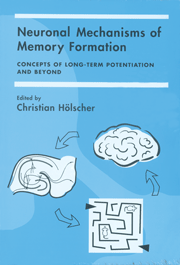Book contents
- Frontmatter
- Contents
- Contributors
- Introduction: Long-Term Potentiation as a Model for Memory Mechanisms: The Story So Far
- Section One Long-Term Potentiation In Vitro and In Vivo: How Can We Fine-Tune the Current Models for Memory Formation?
- Section Two There is More to the Picture Than Long-Term Potentiation: Theta or Gamma Oscillations in the Brain and the Facilitation of Synaptic Plasticity
- 5 Synaptic Potentiation by Natural Patterns of Activity in the Hippocampus: Implications for Memory Formation
- 6 Plasticity in Local Neuronal Circuits: In Vivo Evidence from Rat Hippocampus and Amygdala
- 7 Theta-Facilitated Induction of Long-Term Potentiation: A Better Model for Memory Formation?
- 8 Role of Gamma Oscillations for Information Processing and Memory Formation in the Neocortex
- Section Three Making Models from Empirical Data of Synaptic Plasticity
- Section Four Setting the Stage for Memory Formation: Stress, Arousal, and Attention
- Section Five Transgenic Mice as Tools to Unravel the Mechanisms of Memory Formation
- Conclusions and Future Targets
- Index
5 - Synaptic Potentiation by Natural Patterns of Activity in the Hippocampus: Implications for Memory Formation
Published online by Cambridge University Press: 13 October 2009
- Frontmatter
- Contents
- Contributors
- Introduction: Long-Term Potentiation as a Model for Memory Mechanisms: The Story So Far
- Section One Long-Term Potentiation In Vitro and In Vivo: How Can We Fine-Tune the Current Models for Memory Formation?
- Section Two There is More to the Picture Than Long-Term Potentiation: Theta or Gamma Oscillations in the Brain and the Facilitation of Synaptic Plasticity
- 5 Synaptic Potentiation by Natural Patterns of Activity in the Hippocampus: Implications for Memory Formation
- 6 Plasticity in Local Neuronal Circuits: In Vivo Evidence from Rat Hippocampus and Amygdala
- 7 Theta-Facilitated Induction of Long-Term Potentiation: A Better Model for Memory Formation?
- 8 Role of Gamma Oscillations for Information Processing and Memory Formation in the Neocortex
- Section Three Making Models from Empirical Data of Synaptic Plasticity
- Section Four Setting the Stage for Memory Formation: Stress, Arousal, and Attention
- Section Five Transgenic Mice as Tools to Unravel the Mechanisms of Memory Formation
- Conclusions and Future Targets
- Index
Summary
SUMMARY
Although our understanding of the relationship between hippocampal long-term potentiation (LTP) and learning is limited, a fresh approach presented here bears promise for resolving this important issue. Blockade of LTP frequently leads to blockade of hippocampus-dependent learning, but there are examples of intact learning in the absence of LTP, and the function of LTP during learning is poorly understood. This lack of understanding may partly stem from the preoccupation with tetanus-induced LTP in experimental designs, since such long-lasting high-frequency activity has never been demonstrated to occur in vivo. A closer understanding of memory related plasticity in the brain requires detailed study of the neuronal activity patterns occurring when an animal learns. Replication of natural patterns of activity in an in vitro preparation suggests that bursting activity in hippocampal pyramidal neurons may play a specific role during encoding of new memories. These data have led to the development of a novel model for information processing in cortical networks, in which separate processing modes may coexist.
Introduction
The question of whether long-term potentiation (LTP) is the basis for learning and memory is one of the most exciting and controversial issues in cognitive neuroscience. Previous attempts to link LTP and memory seem to have gone up the wrong path since, in several respects, we are as confused about this important question today as we were 30 years ago. One reason why we went astray might be that in our enthusiasm to use novel cellular and molecular techniques to explore the mechanisms underlying LTP, we forgot what we were actually trying to understand, namely the mechanism of memory.
Information
- Type
- Chapter
- Information
- Neuronal Mechanisms of Memory FormationConcepts of Long-term Potentiation and Beyond, pp. 125 - 136Publisher: Cambridge University PressPrint publication year: 2000
